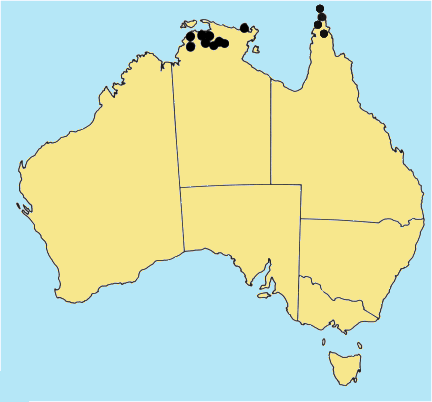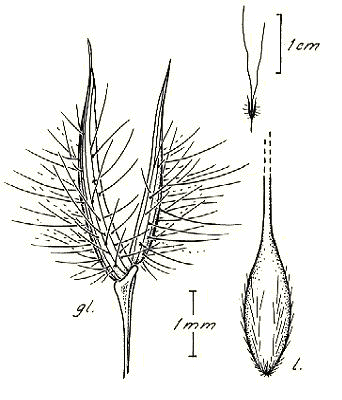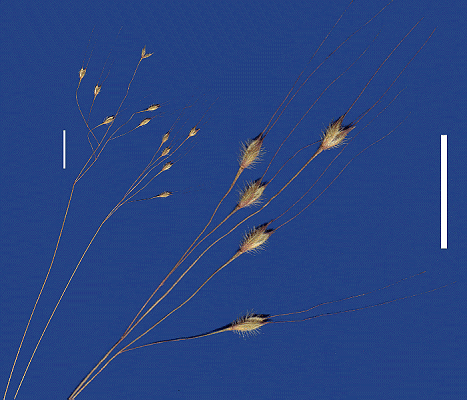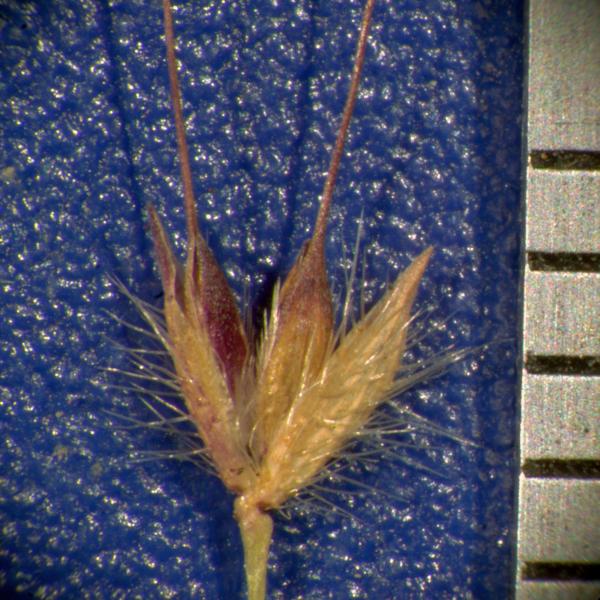Eriachne agrostidea F. Muell. Fragm.
7: 82 (1870).
Classification. (GPWG 2001) : Subfamily
Micrairoideae. Eriachneae.
Type of Basionym or
Protologue Information: ST: Schultz 135, 201, Australia: Northern
Territory: Darwin and Gulf District: Port Darwin (MEL-95274 (central
specimen)). LT designated by Lazarides, Austral. Syst. Bot. 8: 363
(1995); both numbers are mounted on the same sheet, and it is uncertain which
number pertains to which specimen--fide Lazarides.
LT: Schultz 201, Australia: Port Darwin.
Key references (books
and floras): [1878] G.Bentham, Flora Australiensis 7 (628), [2002]
D.Sharp & B.K.Simon, AusGrass, Grasses of Australia.
Illustrations:
[2005] K.Mallet (ed.), Flora of Australia 44B: Poaceae 3 (Fig
27E-F).
Habit. Annual
or ephemeral. Culms 5–44 cm tall. Mid-culm nodes glabrous or bearded. Lateral
branches branched or fastigiate. Ligule a fringe of hairs. Leaf-blades
filiform, 1.5–9 cm long, 0.5 mm wide. Leaf-blade surface indumented.
Inflorescence.
Inflorescence compound, a panicle. Panicle oblong or ovate, dense or loose, 1–7
cm long, 0.5–5 cm wide.
Spikelets.
Spikelets pedicelled. Fertile spikelets 2-flowered, both fertile, comprising 2
fertile floret(s), without rachilla extension, ovate, laterally compressed,
3–3.5 mm long.
Glumes.
Glumes similar, thinner than fertile lemma. Lower glume ovate, membranous,
without keels, 5–7 -nerved. Lower glume surface glabrous or indumented. Lower
glume apex muticous or mucronate or awned. Upper glume ovate, 3–4.3(–6) mm
long, membranous, without keels, 5–7 -nerved. Upper glume surface smooth,
glabrous or indumented. Upper glume apex muticous or mucronate or awned.
Florets.
Fertile lemma 1.8–4 mm long, without keel, 5–7 -nerved. Lemma surface glabrous
or indumented. Lemma apex awned, 1 -awned. Median (principal) awn 4.5–22 mm
long overall. Palea apex entire or erose, muticous. Grain 1.5–2 mm long.
Continental
Distribution: Australasia.
Australian
Distribution: Northern Territory, Queensland.
Northern Territory:
Darwin & Gulf. Queensland: Cook.
Notes.
Resembles E. filiformis in habit and spikelet morphology, but differs by
its sparse panicles of few, distant spikelets (not contracted and rather
dense), longer lemma awn, and shorter blunter callus. Both species are
extremely slender annuals or ephemerals, with compact mainly basal foliage,
florets that are shorter than glumes and often sparsely hairy, awned lemmas
with ciliate submargins and without grooves, and flattened caryopses.
Endemic.
N of 14ºS in Qld and N.T. Commonly in skeletal, sandy, stony or pebbly soil in
association with sandstone, conglomerate or laterite; also recorded from
low-lying and other seasonally moist sites. Flowers and fruits Feb.-May
(late-summer and autumn).






